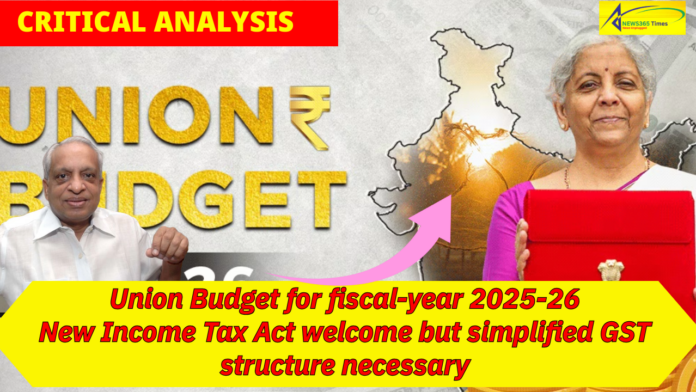bySubhash Chandra Agrawal
Much awaited new Income Tax Act is announced to be introduced shortly in the Union Budget for fiscal-year 2025-26 to replace six decades old Income Tax Act 1961. It should be expected that new Income Tax Act will simplify Direct Tax system. Rather it would have been better that new Income Tax Act would have been simultaneously introduced with the Union Budget. Drastic cut in tax-slabs is welcome, but there is no clarity if surcharges and cess exist or not. Tax-payer is confused if income is tax-free till rupees 12 lakhs per annum with tax-slabs existing for incomes between rupees 4 lakhs and 12 lakhs. Evidently normal tax-payer is not educated enough that it will be possible only due to relief available under section 87A of Income Tax Act 1961. Incomes exceeding rupees 12 lakh will deprive tax-payer of relief available under section 87A of Income Tax Act 1961. Direct tax-system could be most simplified by raising basic tax-exemption limit anywhere between rupees 4 lakhs and rupees 12 lakhs but abolishing confusing relief available under section 87A of Income Tax Act 1961. There should be only one tax-regime abolishing old tax-regime. Net tax-rate should not exceed 30-percent abolishing system of surcharges and cess to be in tune with most other countries of the world in accordance with recommendations of Raja Chelliah Committee for better tax compliance. With tax-slabs drastically cut, tax-exemptions including on charity, donation, contribution to political parties and even agricultural-income which are largely misused should be abolished. An ordinary farmer does not earn more than rupees four lakhs per annum, and the provision is grossly misused by ultra-rich persons including known celebrities to declare their unaccounted income as agricultural income through some village-land purchased only for whitening the black income without having any agricultural produce.
India should step towards cashless economy like in Sweden by taking bold steps to bring cash in circulation in banking economy as was visualised at time of demonetisation of currency on 08.11.2016. A permanent Voluntary Disclosure Scheme can be introduced whereby provision may be there in tax-return to declare at highest suggested tax-rate of 30-percent, any income without disclosing source of income. This will make cash-transaction specially in property-deals accounted if registration-fees on property-deals is also reduced to say just five-percent inclusive of municipal taxes and capital-gain further cut to 10-percent like on shares. Names of all those disclosing incomes under suggested highest 30-percent slab should be on website according to income disclosed so that status-conscious persons may race to disclose more incomes.
LK Jha committee recommendations to make calendar-year as fiscal-year should be implemented to be in line with most countries of the world, thus abolishing another British legacy of following April-March presently as Fiscal Year. It is ridiculous to have different Depreciation-Rules for Tax and Corporate audits. There should be a single and unified Tax and Corporate Audit.
All sale-purchases above rupees 10000 must be compulsorily through bank-transactions. For this, transaction-charges on credit-cards should be slashed down to just half-percent (GST-exempted) that too to be borne by central government with all incentives on purchases made through credit-cards abolished. Present high two-percent transaction-charges on credit-cards make traders charge it separately from customers specially where trade-margins are low. System will fetch much higher tax-revenue for government, than through half-percent transaction-charges to be borne by government. Banks issuing credit-cards will get much-more earning even with half-percent transaction-charge because of manifold use of credit-cards. Two sets of credit-card swapping-machines should be compulsory for every GST-registered dealer so as to avoid declining payment through credit-cards with usual excuse that swapping-machine is out of order. Strict-most action must be there against those refusing payment through credit/debit cards.
Input-Tax-Credit system in GST-regime in manufacturing-sector is biggest corrupt practice of tax-evasion where left-out GST-invoices by ordinary customers are sold by traders to consuming manufacturers or producers to avail false Input-Tax-Credit where cash is paid back by traders to those purchasing left-out GST-invoices of actual consumers bringing more currency in circulation, this being the reason of rapid and regular rise in currency-circulation. Annual forensic audit may be made compulsory on claims made for Input-Tax-Credit by manufacturers/producers to avoid false claims of excessive Input-Tax-Credit in these sectors. Rather study should be made if with abolition of 18-percent GST slab, Input-Tax-Credit can be altogether abolished from manufacturing/producing sectors, retaining it only on tradable commodities.
Input-Tax-Credit system under GST should not be available on expenses like has rightly be done in case of car-expenses for non-commercial use. With such large-scale reduction in Input-Tax-Credit and merging GST-slabs of 3 and 5 percent into a new slab of 6-percent apart from raising 28-percent GST slab to 30-percent, it may be possible to abolish 18-percent GST-slab thus reducing GST-slabs to just 6, 12 and 30-percent. India is the only country which has so many GST-rates. Gradually even slabs of 6 and 12 percent may also be replaced by a new 10-percent tax-structure. Zero-percent GST may only be retained on totally unbranded raw-materials which cannot be consumed without giving a finishing touch like agricultural-products, fish, meat, cotton-yarn etc. All items of long-term use like cars, air-conditioners, TV-sets, refrigerators etc may attract 30-percent GST while their parts may uniformly attract 12-percent GST. It is ridiculous that clutch-plate and clutch-bearing are under different GST-slabs of 18 and 28 percent. Likewise different food-items like sweets, biscuits, namkins etc attract different GST-slabs with luxury sweets causing diabetes attracting just 5-percent GST.
Invoices for items like gold-jewellery can be drawn in two parts, one for metal and embodied items and the other for making-charges so that suggested 12-percent GST may be payable only on making-charges. Cess on extra-luxurious items should be replaced by additional GST-slabs in multiples of 60-percent, also bringing petroleum products under GST-regime to ensure uniform pricing of petrol and diesel in all states.
With GST-slab of 18-percent abolished and service sector then attracting just 12-percent GST, those with income of rupees ten lakhs or more (instead of present rupees 20 lakhs) can be brought under GST-regime like was the system before GST-regime with lawyers also coming under purview of GST-regime. Useless system of Tax-Deducted-At-Source for GST, which is hardly used in practice, should be altogether abolished.
All government-payments can be considered to be exempted from GST to avoid unnecessary government-accounting by putting tax from one government-pocket to other. It is illogical that some premium postal-services like Speed-Post may attract GST while other postal-services do not attract GST. Even illogical and irrational postal-rates (both inland and foreign) need simplification for equal rise of postal-tariff for equal rise in slab-weight in multiples of 50 gms. of inland postal-article with all postal-tariffs being in multiples of rupees ten except for registered-newspapers and post-cards which may cost rupee one with abolition of outdated Inland-Letter-Cards. Presently a postal-article weighing 200 gms sent locally by reliable and fast Speed Post costs just rupees 30 but if sent by unreliable ordinary post, it will cost rupees 50. Likewise foreign-mail tariffs can be fixed for 20 gms or part slab-weight independently for air and sea-surface-mail.
Writer is Guinness World Record Holder for writing most letters and RTI Consultant



